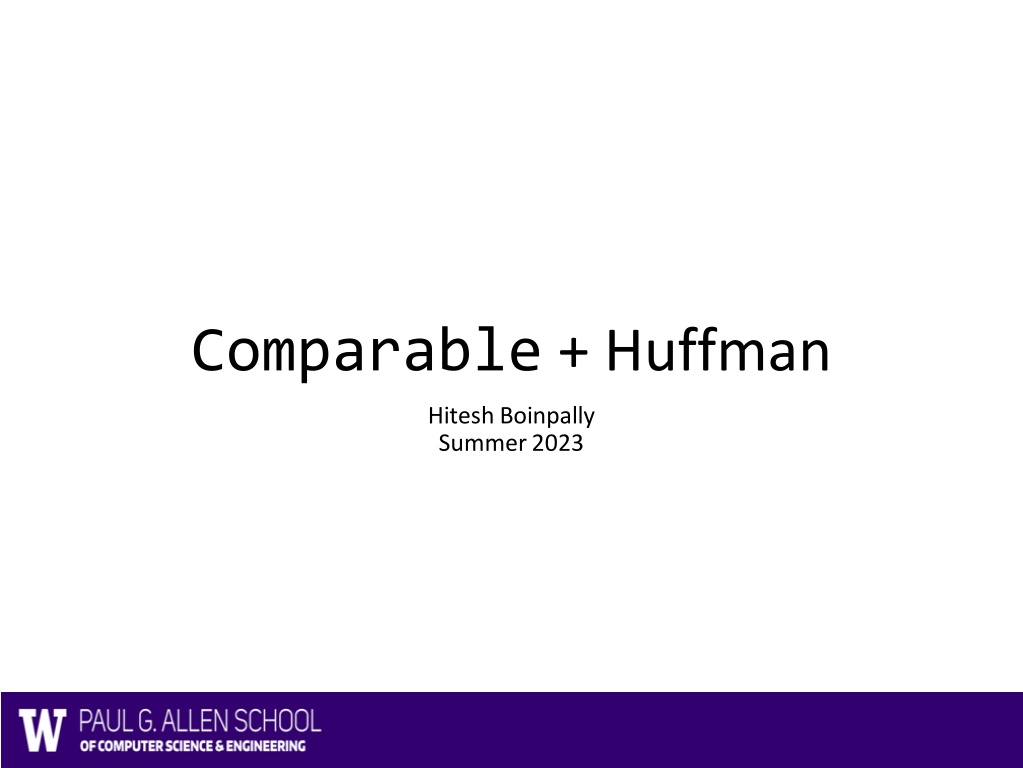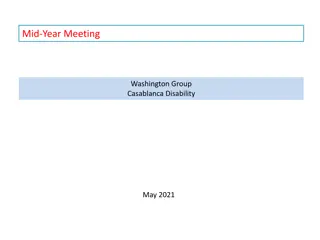Comparable + Huffman
In this content, we delve into Java interfaces and explore the Comparable interface. We discuss how to define a set of behaviors a class can implement using interfaces and the importance of utilizing the Comparable interface for sorting objects. The content also touches on priority queues and Huffman encoding, providing an introduction to these concepts. With images and examples, the material aims to enhance understanding and application of these Java concepts in a Summer 2023 lesson.
Download Presentation

Please find below an Image/Link to download the presentation.
The content on the website is provided AS IS for your information and personal use only. It may not be sold, licensed, or shared on other websites without obtaining consent from the author. Download presentation by click this link. If you encounter any issues during the download, it is possible that the publisher has removed the file from their server.
E N D
Presentation Transcript
Comparable + Huffman Hitesh Boinpally Summer 2023
Agenda Comparable P3 - Huffman Lesson 12 - Summer 2023 2
Agenda Comparable P3 - Huffman Lesson 12 - Summer 2023 3
Interfaces Review Define set of behavior a class can implement Contract , Certification List and Set are some interfaces we ve used To utilize: public class Tesla implements Car Says that Tesla implements the Car interface Lesson 12 - Summer 2023 4
The Comparable Interface Say you had a FootballTeam class and wanted to sort them How could you tell Java how to sort them? Lesson 12 - Summer 2023 5
The Comparable Interface Say you had a FootballTeam class and wanted to sort them How could you tell Java how to sort them? Utilize the Comparable interface! Fixed definition of how to compare objects This is needed to allow objects to be added to TreeSetsand TreeMaps Lesson 12 - Summer 2023 6
Agenda Comparable P3 - Huffman Lesson 12 - Summer 2023 7
Priority Queues and Huffman Encoding Introduction to the Final Project Hunter Schafer CSE 143, Autumn 2021
Priority Queue Priority Queue A collection of ordered elements that provides fast access to the minimum (or maximum) element. public class PriorityQueue<E> implements Queue<E> constructs an empty queue PriorityQueue<E>() add(E value) adds value in sorted order to the queue returns minimum element in queue peek() removes/returns minimum element in queue remove() returns the number of elements in queue size() Queue<String> tas = new PriorityQueue<String>(); tas.add("Watson"); tas.add("Sherlock"); tas.remove(); 1
Priority Queue Priority Queue A collection of ordered elements that provides fast access to the minimum (or maximum) element. public class PriorityQueue<E> implements Queue<E> constructs an empty queue PriorityQueue<E>() add(E value) adds value in sorted order to the queue returns minimum element in queue peek() removes/returns minimum element in queue remove() returns the number of elements in queue size() Queue<String> tas = new PriorityQueue<String>(); tas.add("Watson"); tas.add("Sherlock"); tas.remove(); // "Sherlock" 1
File Compression Compression Process of encoding information so that it takes up less space. Compression applies to many things! Store photos without taking up the whole hard-drive Reduce size of email attachment Make web pages smaller so they load faster Make voice calls over a low-bandwidth connection (cell, Skype) Common compression programs: WinZip, WinRar for Windows zip 2
ASCII ASCII (American Standard Code for Information Interchange) Standardized code for mapping characters to integers Many text files on your computer are in ASCII. But, computers need numbers represented in binary! Character a b c e z ASCII value 32 97 98 99 101 122 3
ASCII ASCII (American Standard Code for Information Interchange) Standardized code for mapping characters to integers Many text files on your computer are in ASCII. But, computers need numbers represented in binary! Every character is represented by a byte (8 bits). Character a b c e z ASCII value 32 97 98 99 101 122 Binary Representation 00100000 01100001 01100010 01100011 01100101 01111010 3
ASCII Example Character a b c e z ASCII value 32 97 98 99 101 122 Binary Representation 00100000 01100001 01100010 01100011 01100101 01111010 What is the binary representation of the following String? cab z 4
ASCII Example Character a b c e z ASCII value 32 97 98 99 101 122 Binary Representation 00100000 01100001 01100010 01100011 01100101 01111010 What is the binary representation of the following String? cab z Answer 01100011 4
ASCII Example Character a b c e z ASCII value 32 97 98 99 101 122 Binary Representation 00100000 01100001 01100010 01100011 01100101 01111010 What is the binary representation of the following String? cab z Answer 01100011 01100001 4
ASCII Example Character a b c e z ASCII value 32 97 98 99 101 122 Binary Representation 00100000 01100001 01100010 01100011 01100101 01111010 What is the binary representation of the following String? cab z Answer 01100011 01100001 01100010 4
ASCII Example Character a b c e z ASCII value 32 97 98 99 101 122 Binary Representation 00100000 01100001 01100010 01100011 01100101 01111010 What is the binary representation of the following String? cab z Answer 01100011 01100001 01100010 00100000 4
ASCII Example Character a b c e z ASCII value 32 97 98 99 101 122 Binary Representation 00100000 01100001 01100010 01100011 01100101 01111010 What is the binary representation of the following String? cab z Answer 01100011 01100001 01100010 00100000 01111010 4
ASCII Example Character a b c e z ASCII value 32 97 98 99 101 122 Binary Representation 00100000 01100001 01100010 01100011 01100101 01111010 What is the binary representation of the following String? cab z Answer 0110001101100001011000100010000001111010 4
Another ASCII Example Character a b c e z ASCII value 32 97 98 99 101 122 Binary Representation 00100000 01100001 01100010 01100011 01100101 01111010 How do we read the following binary as ASCII? 011000010110001101100101 5
Another ASCII Example Character a b c e z ASCII value 32 97 98 99 101 122 Binary Representation 00100000 01100001 01100010 01100011 01100101 01111010 How do we read the following binary as ASCII? 01100001 01100011 01100101 Answer 5
Another ASCII Example Character a b c e z ASCII value 32 97 98 99 101 122 Binary Representation 00100000 01100001 01100010 01100011 01100101 01111010 How do we read the following binary as ASCII? 01100001 01100011 01100101 Answer a 5
Another ASCII Example Character a b c e z ASCII value 32 97 98 99 101 122 Binary Representation 00100000 01100001 01100010 01100011 01100101 01111010 How do we read the following binary as ASCII? 01100001 01100011 01100101 Answer ac 5
Another ASCII Example Character a b c e z ASCII value 32 97 98 99 101 122 Binary Representation 00100000 01100001 01100010 01100011 01100101 01111010 How do we read the following binary as ASCII? 01100001 01100011 01100101 Answer ace 5
Huffman Idea Huffman s Insight Use variable length encodings for different characters to take advantage of frequencies in which characters appear. Make more frequent characters take up less space. Don t have codes for unused characters. Some characters may end up with longer encodings, but this should happen infrequently. 6
Huffman Encoding Create a HuffmanTree that gives a good binary representation for each character. The path from the root to the character leaf is the encoding for that character; left means 0, right means 1. ASCII Table Binary Representation 00100000 01100001 01100010 01100011 01100101 01111010 Huffman Tree Character a b c e z 0 1 b 0 1 a 0 1 c 7
Final Project: Huffman Coding The final project asks you to write a class that manages creating and using this Huffman code. (A) Create a Huffman Code from a file and compress it. (B) Decompress the file to get original contents. 8
Part A: Making a HuffmanCode Overview Input File Contents bad cab 9
Part A: Making a HuffmanCode Overview Input File Contents bad cab Step 1: Count the occurrences of each character in file {' '=1, 'a'=2, 'b'=2, 'c'=1, 'd'=1} 9
Part A: Making a HuffmanCode Overview Input File Contents bad cab Step 1: Count the occurrences of each character in file {' '=1, 'a'=2, 'b'=2, 'c'=1, 'd'=1} Step 2: Make leaf nodes for all the characters. Place in a PriorityQueue c d a b pq freq: 1 freq: 1 freq: 1 freq: 2 freq: 2 9
Part A: Making a HuffmanCode Overview Input File Contents bad cab Step 1: Count the occurrences of each character in file {' '=1, 'a'=2, 'b'=2, 'c'=1, 'd'=1} Step 2: Make leaf nodes for all the characters. Place in a PriorityQueue c d a b pq freq: 1 freq: 1 freq: 1 freq: 2 freq: 2 Step 3: Use Huffman Tree building algorithm (described soon) 9
Part A: Making a HuffmanCode Overview Input File Contents bad cab Step 1: Count the occurrences of each character in file {' '=1, 'a'=2, 'b'=2, 'c'=1, 'd'=1} Step 2: Make leaf nodes for all the characters. Place in a PriorityQueue c d a b pq freq: 1 freq: 1 freq: 1 freq: 2 freq: 2 Step 3: Use Huffman Tree building algorithm (described soon) Step 4: Save encoding to .code file to encode/decode later. {'d'=00, 'a'=01, 'b'=10, ' '=110, 'c'=111} 9
Part A: Making a HuffmanCode Overview Input File Contents bad cab Step 1: Count the occurrences of each character in file {' '=1, 'a'=2, 'b'=2, 'c'=1, 'd'=1} Step 2: Make leaf nodes for all the characters. Place in a PriorityQueue c d a b pq freq: 1 freq: 1 freq: 1 freq: 2 freq: 2 Step 3: Use Huffman Tree building algorithm (described soon) Step 4: Save encoding to .code file to encode/decode later. {'d'=00, 'a'=01, 'b'=10, ' '=110, 'c'=111} Step 5: Compress the input file using the encodings Compressed Output: 1001001101110110 9
Step 1: Count Character Occurrences We do this step for you Input File bad cab Generate Counts Array: index 0 1 32 97 98 99 100 101 ... ... value 0 0 2 2 1 1 0 10
Step 2: Create PriorityQueue Store each character and its frequency in a HuffmanNode object. Place all the HuffmanNodes in a PriorityQueue so that they are in ascending order with respect to frequency c a d b pq freq: 1 freq: 2 freq: 1 freq: 1 freq: 2 11
Step 3: Remove and Merge c a d b pq freq: 1 freq: 2 freq: 1 freq: 1 freq: 2 12
Step 3: Remove and Merge freq: 2 c freq: 1 freq: 1 a d b pq freq: 2 freq: 1 freq: 2 12
Step 3: Remove and Merge freq: 2 d b a pq freq: 1 freq: 2 freq: 2 c freq: 1 freq: 1 12
Step 3: Remove and Merge freq: 3 a d freq: 1 freq: 2 freq: 2 b pq freq: 2 c freq: 1 freq: 1 12
Step 3: Remove and Merge freq: 2 freq: 3 b pq freq: 2 c d a freq: 1 freq: 1 freq: 1 freq: 2 12
Step 3: Remove and Merge freq: 4 b freq: 2 freq: 2 c freq: 1 freq: 1 freq: 3 pq a d freq: 2 freq: 1 12
Step 3: Remove and Merge freq: 4 freq: 3 b pq freq: 2 freq: 2 a d freq: 2 freq: 1 c freq: 1 freq: 1 12
Step 3: Remove and Merge freq: 7 freq: 3 freq: 4 a d b freq: 2 freq: 2 freq: 1 freq: 2 c freq: 1 freq: 1 pq 12
Step 3: Remove and Merge freq: 7 freq: 3 freq: 4 pq a d b freq: 2 freq: 2 freq: 1 freq: 2 c freq: 1 freq: 1 12
Step 3: Remove and Merge freq: 7 freq: 3 freq: 4 pq a d b freq: 2 freq: 1 freq: 2 freq: 2 c freq: 1 freq: 1 What is the relationship between frequency in file and binary representation length? 12
Step 3: Remove and Merge Algorithm Algorithm Pseudocode while P.Q. size > 1: remove two nodes with lowest frequency combine into a single node put that node back in the P.Q. 13
Step 4: Print Encodings Save the tree to a file to save the encodings for the characters we made. 0 1 0 0 1 1 a d b 0 1 c 14
Step 4: Print Encodings Save the tree to a file to save the encodings for the characters we made. Output of save 0 1 0 0 1 1 a d b 0 1 c 14




























